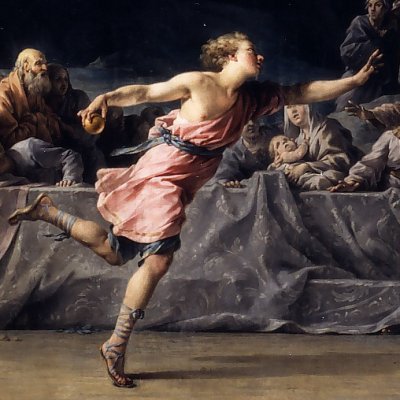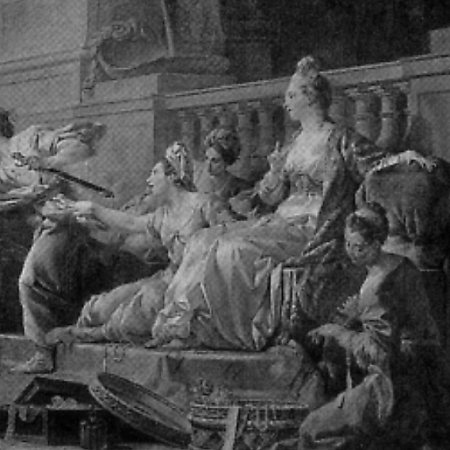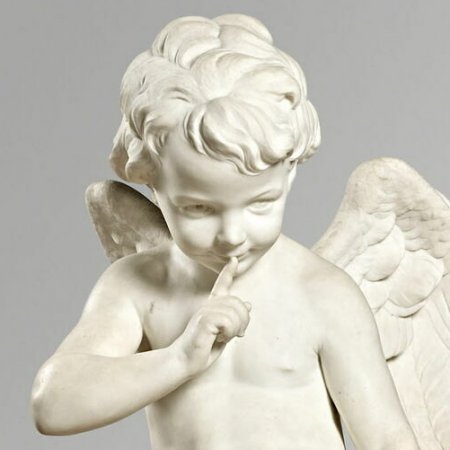The race of Hippomenes and Atalanta - Hallé
Notice précédente Notice n°24 sur 103 Notice suivante
Description
1765 Salon booklet:
"By Mr. Hallé, Professor.
15. [...]
16. The Race of Hippomenes and Atalanta.
This painting, measuring 22 feet wide by 10 feet high, is intended to be reproduced as a tapestry at the Royal Manufactory of Gobelins."
Atalanta challenged all her suitors to a race: only the one who could beat her could marry her. The others were put to death. Venus gives Hippomenes three golden apples, which the young man drops each time Atalanta catches up with him. Atalanta picks them up, allowing Hippomenes to regain the advantage. Hippomenes, in the center, reaches the finish line, a statue of Cupid making a suggestive “Shh” gesture.
Deloynes 8, 107. Critique of the paintings and sculptures of the gentlemen of the Royal Academy. The year 1765. (anonymous, no location) p. 11:
"The composition is pleasing. We see Atalanta suspended in her race on one foot, and Hippomenes picking up a golden apple. Their attitudes [12] are relaxed and delicate. The spectators are eager to know the fate of this young prince, which depends on this race; they all feel the effects of the fear and joy that their uncertainty inspires in them.
The planes of this painting are very beautiful, its colors and softness are very pleasing; but the position in which it is displayed, too high up, is not advantageous to it."
Deloynes 8, 108. Mathon de la Cour, p. 13:
"The same painter composed a large painting to be executed at the Gobelins Manufactory. It depicts the race between Hippomenes and Atalanta. While Atalanta bends down to pick up the golden apples, Hippomenes reaches the end of the race: this point is ingeniously marked by a statue of Cupid. All the spectators are more or less affected by this event, depending on the degree of interest they take in the characters. This painting presents an admirable distance. Hippomenes' right hand [14] has been criticized; he holds a golden apple with the affected grace with which certain dance masters receive tips from their students. I have also seen people who were very confused about which of the two characters was Atalanta. Hyppomenes is blond and has a very delicate complexion; Atalanta is dark-haired: her posture prevents us from seeing her throat, and the muscles of her arm are strongly pronounced. If Hyppomenes' drapery did not reveal part of his chest, the riddle would be impossible to solve.*"
* It was so easy to be mistaken that the author of a critique of these paintings took Hyppomenes for Atalanta; we see there (he says, on page 11): Atalanta suspended in her race on one foot, and Hyppomenes picking up a golden apple.
Mercure de France, October 1765, p. 157:
Everyone enjoyed seeing another large painting by the same artist, intended to be reproduced as a tapestry by the royal Gobelins Manufactory. It depicts the race between Hippomenes and Atalanta. The setting of this painting is very pleasant, and the overall composition is beautifully clear despite the number of figures. Those of Hippomenes and Atalanta are very light and convey the action of the race very well. There is a large group on the side of the track where the judges are; this group and the accessories are rich and abundant in composition, without being confusing. The figures, which are undoubtedly at a suitable distance and life-size, lose a little due to the elevation at which the shape and size of this painting have forced them to be placed: this work should produce a satisfactory effect when executed as a tapestry
2. Commissioned in 1762 by the Bâtiments to be executed as a tapestry at the Gobelins (hanging depicting the Loves of the Gods). The tapestry was never woven, perhaps because there were too many characters, which would have made the cost of the hanging exorbitant. Restored in 1964 and 1991.
3. The next two subjects commissioned from Hallé as part of the same program were Achilles Discovered at the Court of Lycomedes and Silenus Smeared with Blackberries.
Technical Data
Notice #001044





